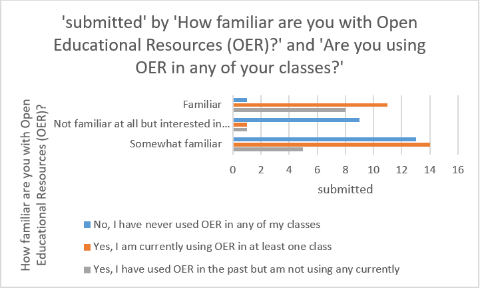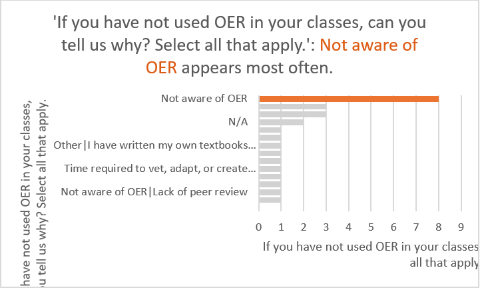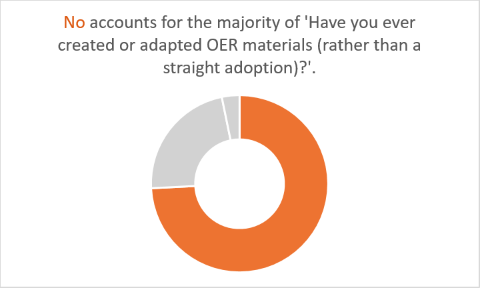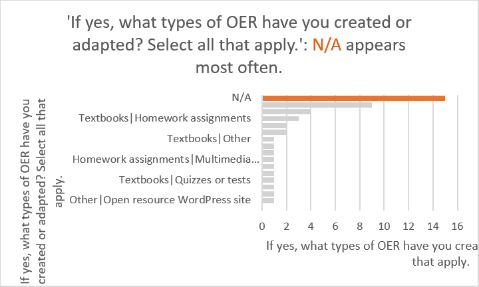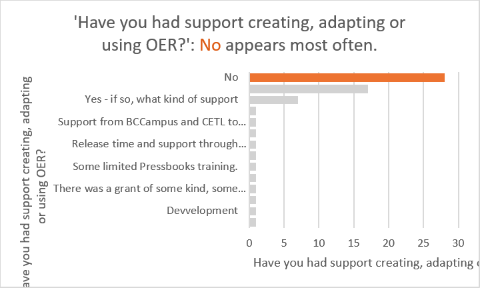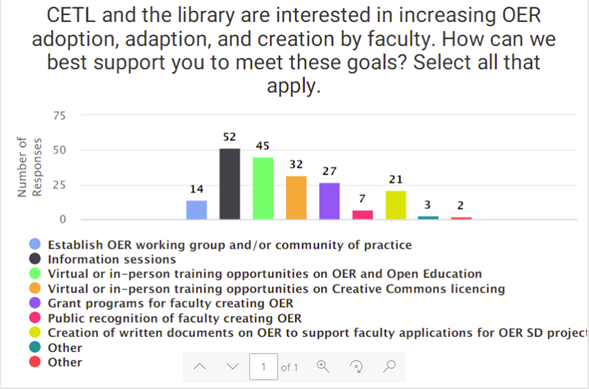Brian Lamb is the Director of Learning Technology & Innovation at Thompson Rivers University (TRU), and he is one of the founders of the Open Educational Technology Collaborative (OpenETC) here in British Columbia. I wrote about the OpenETC in a previous post, but here Brian and I talked about how the OpenETC got started, and some visions they have for the future.
I’ve known Brian for awhile but was really interested in where the idea for OpenETC came from. He began “I’ve been active in open education for most of my time in EdTech, going back to the early 2000s and always thought the open web was a great place to connect with people in other places, share materials, reuse other people’s materials, and collaborate. So, when this thing called Open Education began to take form while I was at UBC, I was able to get support to bring in blog and wiki platforms for the institution.” But then he moved to TRU and “was confronted with the reality of IT departments who are tightly strapped for resources and rightfully wary of people coming in with a boutique project”, because so often people start up projects, work on them for awhile, then move on leaving IT holding the bag. While they had a WordPress installation at TRU, it was quite locked down and didn’t do what Brian needed it to do. He started up something on his own, but quickly realized that being the admin for a service that he wanted to grow was not sustainable.
But Brian had a network to draw on. “As I talked to people at other institutions, I knew that other people were in the same position, for example Grant Potter at the University of Northern British Columbia and Tannis Morgan at the Justice Institute of BC who was doing amazing work with her team at the Justice Institute. So, we thought, rather than all of us struggling individually to run three different WordPress installs, we should pull our resources together and get one good one.”
Brian, Grant, and Tannis spent some time considering different models of hosting. They knew that they wanted a space where they could innovate and collaborate. They started small, collaborating on a WordPress platform they kept fairly small and private, but then were able to get some shared hosting space from BCNet. “That was a huge shift for us because it allowed us to be more open with the platform because we finally had FIPPA-compliant hosting. At that point it started to grow and that’s when we started to think we had a model that we could extend to other people who might want to use these tools.” And that was the moment OpenETC was born.
While WordPress was the main tool the OpenETC started with, they knew other applications were in the same boat with regards to institutional need versus lack of support. “We’re always playing with things. Grant is the most experimental tinkerer of the group, and he’s brought several things to the table that we’ve played with internally, some of which we brought on (Mattermost) and some we decided not to move forward with. One of the things he brought forward early on was Sandstorm.” While unfortunately the developers have not continued to support Sandstorm (which allowed people to run applications without having to install them locally), “that model is very powerful and it’s still our dream, to have a wide range of applications available for people throughout the province to take and run – open applications without third party surveillance. Applications where people can determine the level of privacy they want and have the autonomy to run themselves. We’re still playing with those models but haven’t quite found the framework that we can share widely…yet.”
So, who is the current team supporting the tools they have and with new tools potentially on the way? Brian tells me that while it can be a bit fluid, there is, of course, Brian himself (as one of the founders). There is also Troy Welch, a developer on the team who works with Brian at TRU. But it’s a reciprocal relationship, and while Troy works on elements for OpenETC, he shares those back to TRU, “and other people build things that we can also bring back to TRU.” In addition, OpenETC has support from BCcampus, and BCNet hosts their WordPress service via EduCloud. Then of course Grant Potter (another founder) at UNBC whose WordPress use case was one of the drivers for the creation of the OpenETC and Tannis Morgan who was at the Justice Institute when she started with OpenETC and is now with Vancouver Community College. “The Justice Institute has done amazing with their open WordPress sites, and I wanted to be able to see how they build their stuff, to go into the back end and see what themes they chose, what plugins they used, how they configured them, etc. There’s so much benefit in that kind of sharing.” And in addition to this initial group, “Anne-Marie Scott joined us while she was still at the University of Edinburgh. She happened to be in Vancouver when we were having an in-person event and we invited her along because her group at Edinburgh, in my opinion, may be the best EdTech unit in the world.” She is now a Deputy Provost at Athabasca University and an integral contributor to our planning and operations. And of course, Clint Lalonde from BCcampus gradually became more and more involved as well. “We’re starting to expand now. First of all, anyone who shows up on Mattermost who is engaging with the other participants and the tools, if they want to say they’re part of the OpenETC, that makes us happy.” Then there are people who represent institutions. “We’re starting to expand that group but doing it mindfully in a way that doesn’t spin out of control. For example, bringing people like you, Emily, and Ian Linkletter from BCIT and Liesel Knaak from North Island College – you’re the people who are doing the most, especially institutionally.”
Other organizations have also supported OpenETC. “We haven’t really talked about the role that ETUG (the Educational Technology User Group) plays. Even though there’s not an official relationship between OpenETC and ETUG, I don’t think OpenETC would have worked if ETUG didn’t exist. Because ETUG has created this cohesive community where we share with and help each other. It’s because of groups like ETUG and BCcampus, who emphasize openness and ethical practice as core values, that we have been able to do this work. I don’t think it’s any coincidence that the people that are most active in the OpenETC are the same people that have been active in ETUG for years.”
You might be asking yourself, is OpenETC just for BC? Brian told me that if you understand the model of sharing, we have in BC, supported by ETUG and BCcampus, which in other places seems to be an incredibly radical thing, it really is a natural reflection of the culture that’s evolved here over a long period of time. “Sometimes we’ve had inquiries from people in other provinces about OpenETC. And from a technical point of view, creating your own OpenETC is no harder than setting up your own WordPress server, but how do you develop that culture? A lot of the things I’ve learned through ETUG we try to embody in our OpenETC practice. We don’t talk about it very often because I think it’s just understood; it’s just a shared set of values.”
When I asked if Brian was surprised by the way OpenETC has taken off in the community, he told me “I expected people would use the tools because there was a gap people were struggling with. What I’ve found most amazing is the quality of work being done with the tools. It’s so satisfying to see people at other institutions doing work that they couldn’t have done if not for OpenETC – that’s the coolest thing in the world. I love seeing committed Edtech people, who care about the ethics of what they do, doing such interesting things on the open web. And if you give them some tools and a little bit of help, what they’ll do with it never stops being amazing.”
But institutional collaborators don’t just bring themselves to OpenETC; they also bring students. “It’s always been a given that whatever we make available, we want it to be able to work for students – if it’s something only a specific group of people can use, then it’s not really meeting our purpose. The thing with students is some of them can jump in right away, but the majority of students have never worked with tools like these before. I think that’s a big reason why a lot of faculty are wary of adopting new tools because they know they’re going to spend a lot of time supporting students, so we’ve tried to make the sign-up process as smooth and self-serve as we can.” And they are still working on making the onboarding process smoother, including having more clonable starter sites in WordPress so students (and others) don’t have to start with a blank site. That way “they can feel reasonably good about showing their site to people quickly without having to learn how themes work.” But what Brian really likes about WordPress is that students have the control to change themes, delete and add plugins, widgets, design their sites the way they want to. And Brian is also, as he says, “selfishly excited to see the work students are doing with WordPress”.
I asked what the future holds for OpenETC (and I confess, I was asking specifically whether or not they were considering bringing on a Wiki or other collaborative tool) and Brian assured me that they are having discussions, but don’t want to raise expectations. “We know that Etherpad is an extremely popular application, so we’re probably going to launch that as a stand-alone application which works well for collaborative writing. We’ve talked about Wikis, and if there was significant demand for wiki-like collaborative spaces that Etherpad couldn’t meet, we would have to look at that. We’ve been playing with a framework called Cloudron, which is like an advanced version of Sandstorm in the sense that it lets you deploy apps and includes a number of pretty interesting Wiki applications, but we aren’t sure that it is the right framework for us.” But Brian is interested in creating a kind of middle-ground for more robust and server-intensive applications, where access is limited to those people at institutions who support educational technology, who can then support people at their institutions.
Then there is H5P. “I think one of my dreams is to find ways to make H5P a little easier to support. We’ve talked about creating a dedicated H5P-enabled WordPress theme where we could embed sharing tools and user documentation. It’s been really cool to watch how H5P has been used across the province and I would love to find way to promote and support more activity with it.” Of course, the challenge for Brian and others supporting OpenETC is that this sort of development work is not part of their regular jobs and “unfortunately, a lot of this work ends up being off the sides of all our desks, which is not the way it should be.” Brian would also love to find ways to make it easier for people to share their work across the OpenETC network. “My dream would be to improve discoverability and shareability of H5P objects across sites. And I hope one day to create a framework where you can share your own work more easily.” He has some ideas but thinks this is where the community could really help, because the potential from sharing H5P objects is immense. “We still have a long way to go, but where I think the future of OpenETC will come from people doing do more on the platform and contributing back. If we have more people doing that, we can start to incorporate what they do to make it better. We’re better now already because of the participants, but I really think we’re just starting to see the payoff of wider collaboration across the province.”
As participation and community collaboration grew, it became evident that perhaps OpenETC should adopt some terms of use guidelines. While OpenETC hasn’t been confronted with abuse of content or copyright violations yet, the community began asking about a code of conduct for OpenETC. “Ian Linkletter had developed a code of conduct for his Mattermost installation at UBC, so we adapted his model for our code of conduct and Clint Lalonde did a really good job of facilitating a wider community conversation and getting feedback and input on it. We might not have done it then without that help, but it was something the community wanted, and they were prepared to put in the work to make it happen.”
I asked Brian if OpenETC has seen a lot of growth when COVID hit back in 2020. But he reflected that it’s hard to know because they had been growing before that point and it’s hard to know what the difference would have been without a pandemic pushing everyone online. But numbers of users are not nearly as important or interesting to Brian as seeing unique and interesting applications of the tools from around the province. That being said, with more people signing on, “we hired someone to tighten up the on-ramping for the WordPress clone tool, and to set up better reporting tools so we have a more effective way to look at growth in accounts over time and where they originated. But, while we’ve definitely seen growth, I’m not sure how much we would have seen without COVID and I’d like to believe the work we did to make the platform more accessible, and our regular development plan would have brought people aboard under any conditions.”
As my discussion with Brian drew to a close, I wanted to express to him how much the OpenETC has supported me and my work with faculty and students at Camosun. I was able to set up WordPress sites on the fly to support people during COVID, and have introduced many faculty, program groups, and students to the wonders of setting up their own WordPress sites, and even working with H5P. And I also reflected, and continue to reflect, on more ways I can give back to the OpenETC community. Brian was kind enough to assure me that we at Camosun have been contributing back, saying “we have just been so thrilled to see the work you’re doing, the way you’re giving back, and onboarding. That idea of ‘contributions, not contracts’ has become one of our slogans, and you’ve really grasped that right from the beginning. And I just want to say how much we appreciate how you’ve taken that idea of contributing back seriously.” And I want to say that OpenETC makes it easy, and safe, to play and share back. OpenETC is without a doubt one of the most collegial, supportive, and collaborative groups I’ve ever worked with. I hope to be a part of this community for a very long time!

